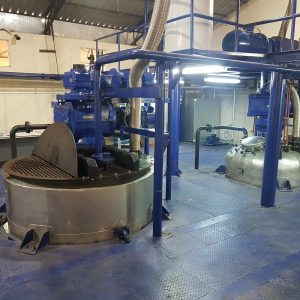 Small batches of grease are normally made in a single vessel. However, big batches are quite often made using a two-stage process where saponification (making the soap thickener in oil) is done in a heated vessel, then the batch is pumped into a cooled vessel for finishing (thinning with oil & mixing in additives).
Small batches of grease are normally made in a single vessel. However, big batches are quite often made using a two-stage process where saponification (making the soap thickener in oil) is done in a heated vessel, then the batch is pumped into a cooled vessel for finishing (thinning with oil & mixing in additives).
Why? A bigger vessel takes longer to heat and cool than a smaller vessel. This is because the vessel jacket surface area does not increase in proportion to volume. It increases by the square root only.
When you are cooling a batch, you are not only cooling the grease, but the heat transfer oil and the vessel metalwork are being cooled as well. For big batches, it therefore makes sense to use a separate vessel that is already cool and has cool oil in its jacket to get a head-start on cooling during the finishing phase. The trade-off is that it increases the capital cost, complexity and the footprint.
We make our two-stage plants operable with both methods in order to increase options for the customer. We do this by providing independently controllable heating and cooling to both the saponification and finishing kettles and giving both vessels access to the mill. If they were to make a complete batch in the larger finishing kettle, they would risk running for 8 hours for each batch, but that is a trade-off known in advance.
Is there a way to make a batch in a large single vessel, without the risk of going beyond 8 hours? We believe it is possible by adding a Scraped Surface Heat Exchanger (SSHE) to circulate the batch through to increase heating and cooling rates.
